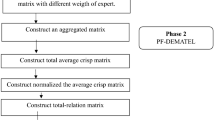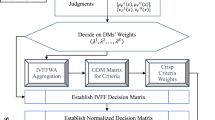Abstract
Most complex decisions involve several stakeholders and therefore need to be solved using a group multi-criteria decision method. However, stakeholders or decision-makers often have divergent views, especially in the environmental sector. In order to integrate this divergence, a new group fuzzy PROMETHEE approach is introduced to combine the traditional environmental criteria of life cycle assessments with social and economic criteria. The modelling of uncertainty within the group of decision-makers using a fuzzy approach makes this method unique. The proposed fuzzy approach differs significantly from the standard one. The decision-makers express their judgments in crisp forms. In order to take into account the intrinsic dispersion of judgments within the group, a posteriori fuzzification procedure is applied. The crisp values are not simply aggregated; they are converted into a triangular fuzzy number based on the given evaluations. As a consequence, the definition of fuzzy membership functions, as required in standard fuzzy logic, is not required, which simplifies the process and makes it more reliable. The new approach is illustrated with a real case study concerning the selection of the best waste treatment solution in a natural park from among a traditional incinerator and an innovative integrated plant.




Similar content being viewed by others

Abbreviations
- I :
-
Number of alternatives
- M :
-
Number of decision-makers
- J :
-
Number of leave criteria
- R :
-
Number of criteria
- J O :
-
Set of quantitative (i.e. objective) leave criteria
- J S :
-
Set of qualitative (i.e. subjective) leave criteria
- J :
-
Set of leave criteria where \( J = J^{\text{O}} \cup J^{\text{S}} \), with \( J^{\text{O}} \cap J^{\text{S}} = \emptyset \)
- a i :
-
Alternative, where \( i = 1, \ldots ,I \)
- d m :
-
Decision-maker, where \( m = 1, \ldots ,M \)
- c j :
-
Leave criterion, where \( j = 1, \ldots ,J \)
- l j :
-
Level of c j in the hierarchy, where \( j = 1, \ldots ,J \)
- c r :
-
Criterion, where \( r = 1, \ldots ,R \)
- \( \Gamma\left( {c_{r} } \right) \) :
-
\( \left\{ {{\text{sub - criteria of}} c_{r} } \right\} \), where r = 1,…,R
- w m,r :
-
Weight assigned to c r by d m , where \( r = 1, \ldots ,R \) and \( m = 1, \ldots ,M \)
- w m,j :
-
Weight assigned to c j by d m , where \( j = 1, \ldots ,J \) and \( m = 1, \ldots ,M \)
- x i,j :
-
Value of alternative a i for the criterion c j , where \( i = 1, \ldots ,I \) and \({c_{j}} {\in} {J^{\text{O}}}\)
- x i,m,j :
-
Value of alternative a i for the criterion c j given by decision-maker d m , where \( i = 1, \ldots ,I \), \( c_{j} \in J^{\text{S}} \), and \( m = 1, \ldots ,M \)
References
Achillas C, Moussiopoulos N, Karagiannidis A et al (2013) The use of multi-criteria decision analysis to tackle waste management problems: a literature review. Waste Manag Res 31:115–129. doi:10.1177/0734242X12470203
Boesch ME, Vadenbo C, Saner D et al (2014) An LCA model for waste incineration enhanced with new technologies for metal recovery and application to the case of Switzerland. Waste Manag 34:378–389. doi:10.1016/j.wasman.2013.10.019
Brans JP (1982) L’ingénierie de la décision: elaboration d’instruments d’aide à la décision. In: Nadeaeu R, Landry M (eds) L'aide à la décision: nature, instruments et perspectives d’avenir. Presse de l'Université de Laval, Québec, pp 183–213
Brans JP, Vincke P (1985) A Preference Ranking Organisation Method: (The PROMETHEE Method for Multiple Criteria Decision-Making). Manag Sci 31:647–656. doi:10.1287/mnsc.31.6.647
Chhipi-Shrestha GK, Hewage K, Sadiq R (2015) “Socializing” sustainability: a critical review on current development status of social life cycle impact assessment method. Clean Technol Environ Policy 17:579–596. doi:10.1007/s10098-014-0841-5
Cole RJ, Sterner E (2000) Reconciling theory and practice of life-cycle costing. Build Res Inf 28:368–375. doi:10.1080/096132100418519
Di Gianfilippo M, Costa G, Pantini S et al (2015) LCA of management strategies for RDF incineration and gasification bottom ash based on experimental leaching data. Waste Manag. doi:10.1016/j.wasman.2015.05.032
Dorini G, Kapelan Z, Azapagic A (2011) Managing uncertainty in multiple-criteria decision making related to sustainability assessment. Clean Technol Environ Policy 13:133–139. doi:10.1007/s10098-010-0291-7
El Hanandeh A, El-Zein A (2010) The development and application of multi-criteria decision-making tool with consideration of uncertainty: the selection of a management strategy for the bio-degradable fraction in the municipal solid waste. Bioresour Technol 101:555–561. doi:10.1016/j.biortech.2009.08.048
Erses Yay AS (2015) Application of life cycle assessment (LCA) for municipal solid waste management: a case study of Sakarya. J Clean Prod 94:284–293. doi:10.1016/j.jclepro.2015.01.089
EUR 23021 EN - Joint Research Centre - Institute for Environment and Sustainability (2007) Environmental assessment of municipal waste management scenarios: Part I—Data collection and preliminary environmental assessments for life cycle thinking pilot studies
EUR 23021 EN/2 - Joint Research Centre - Institute for Environment and Sustainability (2007) Environmental assessment of municipal waste management scenarios: Part II—Detailed Life Cycle Assessments
Fiksel J, Bruins R, Gatchett A et al (2014) The triple value model: a systems approach to sustainable solutions. Clean Technol Environ Policy 16:691–702. doi:10.1007/s10098-013-0696-1
Gamberini R, Gebennini E, Grassi A, Mora C (2008) An innovative model for WEEE recovery network management in accordance with EU directives. Int J Environ Technol Manag 8:348–368. doi:10.1504/IJETM.2008.017507
Gamberini R, Gebennini E, Rimini B (2009) An innovative container for WEEE collection and transport: details and effects following the adoption. Waste Manag 29:2846–2858. doi:10.1016/j.wasman.2009.07.006
Gamberini R, Del Buono D, Lolli F, Rimini B (2013a) Municipal solid waste management: identification and analysis of engineering indexes representing demand and costs generated in virtuous Italian communities. Waste Manag 33:2532–2540. doi:10.1016/j.wasman.2013.06.003
Gamberini R, Rimini B, Nicandri P (2013b) Composting of municipal solid waste: an empirical analysis of existing plants. Trans ASABE 56:1887–1893. doi:10.13031/trans.56.9819
Hauschild MZ, Dreyer LC, Jørgensen A (2008) Assessing social impacts in a life cycle perspective-Lessons learned. CIRP Ann: Manuf Technol 57:21–24. doi:10.1016/j.cirp.2008.03.002
Herva M, Roca E (2013) Review of combined approaches and multi-criteria analysis for corporate environmental evaluation. J Clean Prod 39:355–371. doi:10.1016/j.jclepro.2012.07.058
Hwang CL, Yoon K (1981) Multiple attribute decision making methods and applications: a state-of-the-art survey. Springer, New York
International Standard ISO 14040 (2006) Environmental Management—Life Cycle Assessment—Principles and Framework. International Organization for Standardization, Geneva
Ishizaka A, Nemery P (2011) Selecting the best statistical distribution with PROMETHEE and GAIA. Comput Ind Eng 61:958–969. doi:10.1016/j.cie.2011.06.008
Ishizaka A, Nguyen NH (2013) Calibrated fuzzy AHP for current bank account selection. Expert Syst Appl 40:3775–3783. doi:10.1016/j.eswa.2012.12.089
Jolliet O, Margni M, Charles R et al (2003) IMPACT 2002+: a new life cycle impact assessment methodology. Int J Life Cycle Assess 8:324–330. doi:10.1007/BF02978505
Klöpffer W (2008) Life cycle sustainability assessment of products (with comments by Helias A. Udo de Haes, p. 95). Int J Life Cycle Assess 13:89–95. doi:10.1065/lca2008.02.376
Kumar PR, Jayaram A, Somashekar RK (2009) Assessment of the performance of different compost models to manage urban household organic solid wastes. Clean Technol Environ Policy 11:473–484. doi:10.1007/s10098-009-0204-9
Laurent A, Bakas I, Clavreul J et al (2014a) Review of LCA studies of solid waste management systems—Part I: lessons learned and perspectives. Waste Manag 34:573–588. doi:10.1016/j.wasman.2013.10.045
Laurent A, Clavreul J, Bernstad A et al (2014b) Review of LCA studies of solid waste management systems—Part II: methodological guidance for a better practice. Waste Manag 34:589–606. doi:10.1016/j.wasman.2013.12.004
Liu H, You J, Lu C, Chen Y (2015) Evaluating health-care waste treatment technologies using a hybrid multi-criteria decision making model. Renew Sustain Energy Rev 41:932–942. doi:10.1016/j.rser.2014.08.061
Mardani A, Jusoh A, Zavadskas EK (2015) Fuzzy multiple criteria decision-making techniques and applications—Two decades review from 1994 to 2014. Expert Syst Appl 42:4126–4148. doi:10.1016/j.eswa.2015.01.003
Margallo M, Aldaco R, Irabien Á (2014) Environmental management of bottom ash from municipal solid waste incineration based on a life cycle assessment approach. Clean Technol Environ Policy 16:1319–1328. doi:10.1007/s10098-014-0761-4
Margallo M, Taddei MBM, Hernández-Pellón A et al (2015) Environmental sustainability assessment of the management of municipal solid waste incineration residues: a review of the current situation. Clean Technol Environ Policy. doi:10.1007/s10098-015-0961-6
Milani M, Montorsi L, Stefani M (2014) An integrated approach to energy recovery from biomass and waste: anaerobic digestion-gasification-water treatment. Waste Manag Res 32:614–625. doi:10.1177/0734242X14538307
Morrissey AJ, Browne J (2004) Waste management models and their application to sustainable waste management. Waste Manag 24:297–308. doi:10.1016/j.wasman.2003.09.005
Norris G (2001) Integrating life cycle cost analysis and LCA. Int J Life Cycle Assess 6:118–120. doi:10.1007/BF02977849
Ordoobadi S (2009) Development of a supplier selection model using fuzzy logic. Supply Chain Manag: Int J 14:314–327
Quirós R, Gabarrell X, Villalba G et al (2014) The application of LCA to alternative methods for treating the organic fiber produced from autoclaving unsorted municipal solid waste: case study of Catalonia. J Clean Prod. doi:10.1016/j.jclepro.2014.04.018
Rebitzer G, Hunkeler D (2003) Life cycle costing in LCM: ambitions, opportunities, and limitations. discussing a framework. Int J Life Cycle Assess 8:253–256
Saaty T (1980) The analytic hierarchy process. McGraw Hill, New York
Sikdar SK (2007) Sustainability and recycle-reuse in process systems. Clean Technol Environ Policy 9:167–174. doi:10.1007/s10098-007-0087-6
Soltani A, Hewage K, Reza B, Sadiq R (2015) Multiple stakeholders in multi-criteria decision-making in the context of municipal solid waste management: a review. Waste Manag 1:318–328. doi:10.1016/j.wasman.2014.09.010
Swiss Centre for Life Cycle Inventories (2009) Ecoinvent database V2.1. Dübendorf, Switzerland. www.ecoinvent.org
Tan RR (2005) Application of symmetric fuzzy linear programming in life cycle assessment. Environ Model Softw 20:1343–1346. doi:10.1016/j.envsoft.2004.11.014
Tan RR (2008) Using fuzzy numbers to propagate uncertainty in matrix-based LCI. Int J Life Cycle Assess 13:585–592. doi:10.1007/s11367-008-0032-x
Tan RR, Culaba AB, Purvis MRI (2002) Application of possibility theory in the life-cycle inventory assessment of biofuels. Int J Energy Res 26:737–745. doi:10.1002/er.812
Tan RR, Culaba AB, Purvis MRI (2004) POLCAGE 1.0—a possibilistic life-cycle assessment model for evaluating alternative transportation fuels. Environ Model Softw 19:907–918. doi:10.1016/j.envsoft.2003.10.004
Tan RR, Culaba AB, Aviso KB (2008) A fuzzy linear programming extension of the general matrix-based life cycle model. J Clean Prod 16:1358–1367. doi:10.1016/j.jclepro.2007.06.020
UNEP/SETAC (2009) Guidelines for social life cycle assessment of products. UNEP/SETAC Life Cycle Initiative, Druk in de weer
UNEP/SETAC (2011) Towards a life cycle sustainability assessment: making informed choices on products. UNEP/SETAC Life Cycle Initiative, Paris
UNEP/SETAC (2013) The methodological sheets for subcategories in social life cycle assessment (S-LCA): pre-publication version. UNEP/SETAC Life Cycle Initiative, Paris
Vázquez-Rowe I, Golkowska K, Lebuf V et al (2015) Environmental assessment of digestate treatment technologies using LCA methodology. Waste Manag. doi:10.1016/j.wasman.2015.05.007
Vinodh S (2011) Assessment of sustainability using multi-grade fuzzy approach. Clean Technol Environ Policy 13:509–515. doi:10.1007/s10098-010-0333-1
Zadeh LA (1965) Fuzzy sets. Inf Control 8:338–353. doi:10.1016/S0019-9958(65)90241-X
Acknowledgments
This research was partly funded by the EU as part of the project LIFE08 ENV/IT/000388 RELS—Innovative chain for energy recovery from waste in natural parks (for more details see www.life-rels.eu).
Author information
Authors and Affiliations
Corresponding author
Appendix
Rights and permissions
About this article
Cite this article
Lolli, F., Ishizaka, A., Gamberini, R. et al. Waste treatment: an environmental, economic and social analysis with a new group fuzzy PROMETHEE approach. Clean Techn Environ Policy 18, 1317–1332 (2016). https://doi.org/10.1007/s10098-015-1087-6
Received:
Accepted:
Published:
Issue Date:
DOI: https://doi.org/10.1007/s10098-015-1087-6



